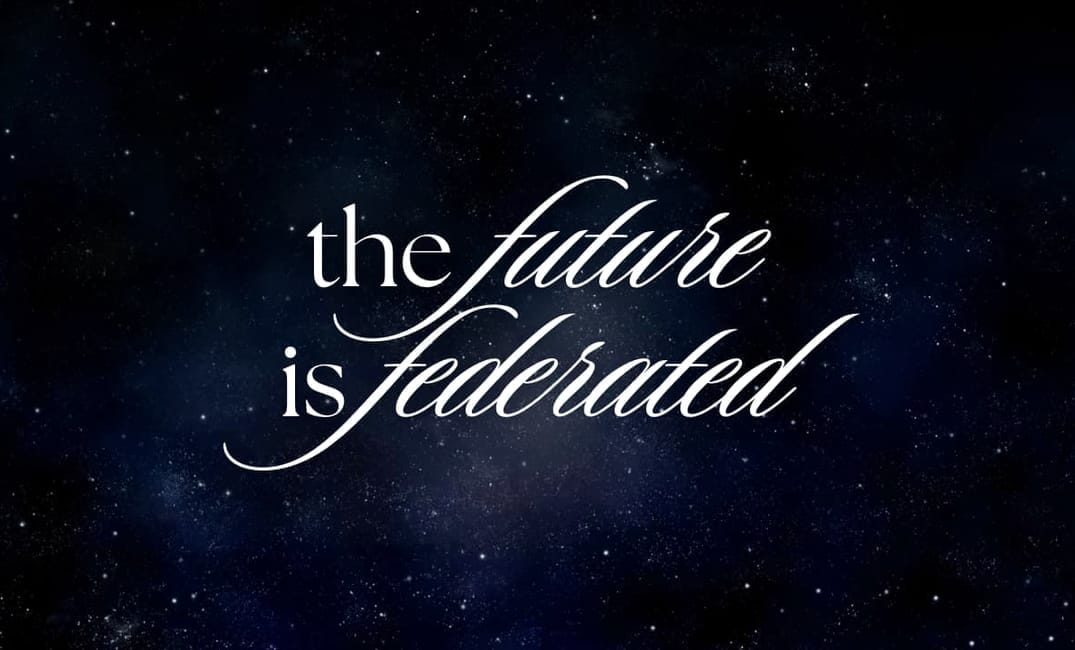The Fediverse has been teaching me how to be a better digital citizen. Actually, let me rephrase that: without the shadow of a doubt, the Fediverse has made me a better digital citizen.
You may have heard in passing how Fediverse networks are considered to be “ethical social media” – but this description has rarely been followed up by an explanation of how and why. I’d like to give it a shot, through the prism of my personal experience.
A word about "behavior modification empires"
When we talk about the Fediverse and all its advantages we often focus on technical details, mentioning decentralized servers, chronological feeds, data sovereignty, and freedom from advertising and ad tracking. I strongly believe we need to also talk about something intangible, beyond technical specs: the values of the Fediverse and FOSS communities. Why?
It’s undeniable that tech platforms are subtly training people to behave a certain way online.
In his book “Ten Arguments for Deleting Your Social Media Accounts Right Now” (2018) technologist Jaron Lanier wrote:
Something entirely new is happening in the world. Just in the last five or ten years, nearly everyone started to carry a little device called a smartphone on their person all the time that’s suitable for algorithmic behavior modification. [...] We’re being tracked and measured constantly, and receiving engineered feedback all the time. [...] Now everyone who is on social media is getting individualized, continuously adjusted stimuli, without a break, so long as they use their smartphones. What might once have been called advertising must now be understood as continuous behavior modification on a titanic scale.
Let's re-read the last line and think about it for a second: "Continuous behavior modification on a titanic scale."
Here of course Lanier was referring to mainstream social platforms, not the Fediverse. In the book Lanier calls Silicon Valley’s social platforms “behavior modification empires.”
What sort of behavior do Big Tech platforms encourage in their users? I wrote this a while back for my blog The Realists:
it seems that people today – across genders, ages and nationalities – share a common desire: to go “viral”, to become influencers, or simply to have their posts and photos accrue as many likes and comments as possible. Being seen, being liked, commanding positive attention on the internet is the ultimate status symbol.
The algorithms of mainstream tech platforms reward people who post frequently and downrank posts by those who are only publishing things sporadically. The implicit rule is: post often so that your content will be seen. In reality all these posts are a goldmine for the platforms’ advertisers and for the training of their large language models.
The Fediverse stands in contrast to all this.
The way I see things, there are three pillars that are of tantamount importance to the developers AND the people of the Fediverse:
- fostering genuine connection
- protecting privacy and enforcing consent
- championing accessibility
The people of the Fediverse - compared to people on mainstream social media - also exhibit a high degree of digital media literacy: they are keenly aware of surveillance capitalism, adtech, and the harvesting of private user data to train AI models. These are some of the reasons why people may be in the Fediverse in the first place - and we shouldn't take this for granted.
1) My People, striving for genuine connection
Something I think about everyday is that in the Fediverse I have found my people. I feel at home there, interacting with people who share my values, and I appreciate having a refuge from the thirst traps and engagement bait that are rampant on other social media platforms.
While many people on Threads, Bluesky, Instagram, TikTok and X are constantly striving to "go viral" and be seen by a large audience, I feel that these goals are a turnoff in the Fediverse. And I LOVE that.
I cannot recall a single post on Mastodon, Friendica or Pixelfed from the past year showing a photo that would qualify as a “thirst trap”. Or toots that could be described as “engagement bait.” And hey, no judgement for Fediverse people who genuinely like posts that qualify as “thirst traps” and “engagement bait”. My point is that with the lack of algorithmic feeds, I am not force-fed content from people I do not follow, whose purpose is to draw attention. I don’t follow any accounts who engage in that behavior and because feeds are chronological and only show posts by people I actually follow, I don’t see content that is undesirable to me. Ever.
In contrast, the second I open Threads or Bluesky, I am submerged by messages in the For You and Discover feeds that are brazen attempts at engagement bait but ultimately hollow in meaning and value – to me, personally.
Half the time I’m on Threads – and mind you, I’m only there to promote the real Fediverse – I spend my time clicking on the three grey dots in the upper right corner of a post and select “Not Interested”. I’d go so far as to say that Threads feels like a text-based version of TikTok, with an unpredictable, slot machine-like algorithm that may make one’s post go viral. The platform understands the dopamine hits it serves with this promise of sudden virality and exploits it to the max, keeping “For You” as the default feed one sees when they open the Threads app. To me this is the equivalent of eating a bag of salty chips: addictive, can’t resist eating the next, but it does not qualify as a nourishing meal.
But wait! You may say. Meta says Threads will be part of the Fediverse and has already turned on one-way federation. Yes, I know. In the same way this brilliant article by @rysiek called out Bluesky for “cosplaying decentralization” I’d venture to say that Threads is doing the same.
It’s time to acknowledge that it’s a basic human need to feel seen, heard and valued. Of course we all want that. My issue is with the design of Big Tech social platforms that exploit this primal need and drive a race “to the bottom of the brain stem” for their own financial gain and influence.
The web has democratized access to people and allowed seamless interactions; then the social web that spun out of Menlo Park veered our online spaces in a different direction, a place where visible metrics and unpredictable, opaque algorithms ruled. Social connections became gamified and quantified for the purposes of surveillance capitalism, mediated by Big Tech companies; platforms gave the illusion of offering a service that connects people but made their money from tracking them and serving them ads. People online are “users” (the same language used to describe drug addicts) and content appears in “feeds” (language employed to describe livestock).
A few years ago I interviewed artist and activist Ben Grosser who said on the subject of metrics:
Because the platform is foregrounding [the] number of likes you get, it's really training you: “post things that get more likes”. The entire system is based on people posting things that will be the most engaging to everyone else. Social media platforms are dependent on... not whether we have a good experience; they're dependent on how much content we give them. The more content we give them, the better it is for them, then they have more information to understand what we like, what we don't like, and they can use that in advertising, to suggest new events, to suggest new friends, to keep us further engaged. So the presence of these numbers are influencing us in all kinds of ways.
By contrast, the Fediverse gives me flashbacks to the days of Web 1.0 and its promise of real connections with interesting people - regardless of their geographic location.
In the Fediverse there is no emphasis on numbers and popularity - just the ability to connect with people that are interesting to you. Their messages appear in chronological order. And if you want to make sure you don’t miss anything by your favorite people, you can browse your Fediverse feed using phanpy.social’s brilliant catch-up feature where you see posts grouped by author. If you are curious about reading only the posts of a certain person you can click on the photo of their avatar and you are presented with their posts, in chronological order. As simple as that.
I have connected with so many fascinating people during my time in the Fediverse (too many to mention!) and I have learned and grown so much. Just over the past 3 months I have had an education in Fediverse interoperability (thanks to the generous advice and help of many developers on Mastodon and Friendica), I started learning about Matrix and FOSS projects, and I’m now even planning to attend the next Fosdem! Because of the great generosity of people in the Fediverse towards me, I have also been inspired to give back and help people who messaged me with help requests.
I have found a wholesome spirit of collaboration in the Fediverse, which has made me a better digital citizen. If Threads feels like a bag of chips, the Fediverse for me is a tofu bibimbap: healthy and nourishing. I feel like I can be myself and post things I like because there is no emphasis on algorithms or virality. I can quickly catch-up with my favorite people using Phanpy because there is no vested interest in keeping me scrolling for as long as possible for vanity metrics for the platform’s VCs. The platforms serve my needs - not the other way around. And, most important of all, I have found my tribe: people deeply invested in moving the Fediverse forward and creating healthier online spaces.
2) In defense of privacy & consent
I feel that the people of the Fediverse put premium value on privacy and consent - like I do.
With few exceptions, it’s exceedingly rare for me to see photos of minors (someone’s child) show up in my Mastodon, Friendica or Pixelfed feeds. Cats and dogs, yes. Humans not so much. And I LOVE that.
I’m a photographer with thousands of gorgeous photos of my child taken since she was born. I have never published a single photo online that shows her face. I may have published a handful of her from the back, but that’s about it. 3 or 4 tops - in 3 1/2 years. I also have never posted her name and I love to keep things this way.
In 2024, at a time when Big Tech vulgarized and cheapened the meaning of the word “friend”, I can easily tell who my real life friends are: they know my child’s name and what she looks like because they have met her. Far away friends whom I’ve not seen since her birth - because of geographic distance - know her name and what she looks like because I send them photos via private conversation in a messaging app. Everyone else is an acquaintance or professional contact. And being able to make these distinctions is a very good thing in my book.
“Sharenting” - and especially influencers’ practice of commodifying their entire existence and broadcasting every private moment of their babies and children's lives on social media for the purposes of engagement and even monetization - is something that makes my blood boil.
Sharenting is rampant on Instagram, even amongst regular users; the platform has been around for 14 years and the most popular type of content is photos of cute pets, adorable children, selfies and thirst traps. Going back to Ben Grosser’s words, the app is teaching people to “post things that get likes”. I understand. The practice is so common that people don’t think twice about it.
The lack of permission from small children (too young to give consent) and the daily broadcasting of private, intimate family moments on public accounts in exchange for likes and comments is my red line. Please note I wrote “public accounts” – I know many people have private Instagram accounts with the goal of sharing photos with real life friends they have accepted as connections. I wouldn’t do it on a Meta platform, but I can understand how it’s easy and convenient for many. My animosity towards “sharenting” is reserved for people posting photos on public accounts, trading their children’s privacy for digital dopamine hits.
I wrote on my blog The Realists about the dangers of sharing children’s photos online and heard… crickets as feedback. Still, it’s worth reposting here a quote from Christian Loefert, Telekom Germany's head of marketing communications, whose company produced a powerful PSA (“Without Consent”). Loefert said in an interview:
Every person has the right to decide on his or her own digital identity. [...] Studies show that an average five-year-old child has already had around 1,500 pictures uploaded without their consent by those they trust most: their parents. This material is unprotected on the net.
Again, totally subjective you may say, but I feel that people of the Fediverse get this and are keenly aware of privacy issues and the need for consent.
Scrolling through Pixelfed.social’s local feed right now, these are the first 10 photos I see:
- a mural
- a cat perched on a windowsill
- the close-up of a flower
- a coffee cup
- a colorful entrance to a building
- the wide shot of a seaside panorama
- the close-up photo of an insect
- a light bulb
- light streaming in a church from a window
- the close-up of a cat sitting on a chair
I can’t really compare this exercise to Instagram because I have muted too many accounts in my feed. There is no such thing as browsing a public “local feed” on Instagram - all you have is an assortment of algorithmically selected photos and videos in Explore that are based on people’s past behavior in the app. In general though, if I were on Instagram I would see for the most part family snapshots, selfies, hyper-idealized portraits of people and lots and lots of ads. Very little photography or interesting urban scenes.
And now you may play devil’s advocate and say: how has the Fediverse changed you in this respect, if you were already privacy-conscious? Well, for starters, it has made me feel less alone.
99% of my friends are non-technical people who use apps by Big Tech on a daily basis. Whenever I discuss my stance on privacy, data ownership and adtech I feel like an oddball wearing a tinfoil hat. Aw the looks I get when I tell friends and acquaintances “please don’t DM me on Instagram, I rarely use the app and keep it on a burner phone that’s always home.” But people in the Fediverse / FOSS communities would react in a different way. “Wait, you have an Instagram account?!?”
And that’s precisely why they are my people.
Next week, in part 2, I will discuss the Fediverse’s biggest impact on me as a digital citizen: teaching me to be aware of and mindful of accessibility.
Thanks for being here,
Elena
P.S.: If you want to catch up on all the previous posts for The Future is Federated, you can find them here:

💓 Did you enjoy this post? Share it with a friend!
👫 Follow me on Mastodon (my favorite network!) or Pixelfed. All my other links are available here: elena.social
📽️ If you'd like to support my work, you could buy or rent my documentary The Illusionists on the globalization of beauty. Watch the teaser:

💌 If you'd like to say hi, my contact information is here
✏️ If this post resonated with you, leave a comment!


